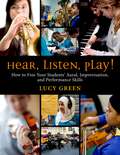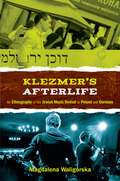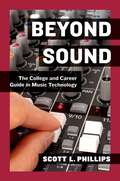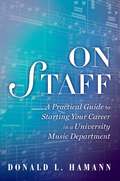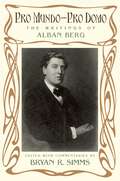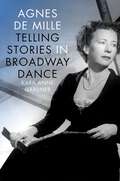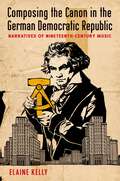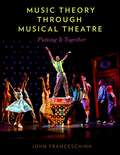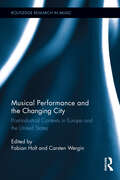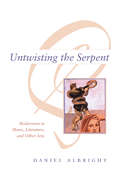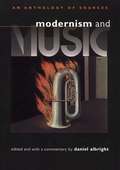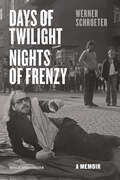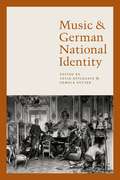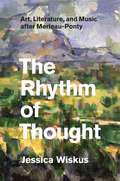- Table View
- List View
Hear, Listen, Play!: How to Free Your Students' Aural, Improvisation, and Performance Skills
by Lucy GreenHear, Listen, Play! is a book for all music teachers who are unfamiliar with, yet curious about the worlds of ear-playing, informal learning, improvisation, and vernacular musics. For decades, or even hundreds of years, a divide has slowly been developing between the realms of notation-based musical transmission, and aural/oral methods. Yet that divide is by no means a necessary aspect of music learning, and musicians who are lucky enough to dwell on both sides of it count themselves as so much the richer for doing so. This book aims to provide a door into those other worlds for any teacher who would like to open it. Starting with a brief discussion of how popular musicians learn in the informal realm, the book then applies many aspects of their learning practices to three main areas within music education. Firstly it tackles the one-to-one specialist instrumental lesson, then ensemble work such as band and orchestra; and finally the generalist or specialist classroom. The methods within each section have been systematically tried and tested in research projects spanning more than a decade, yet the book is written in simple, non-academic language which teachers will quickly find applicable to their working lives. Vignettes from the research participants themselves provide color throughout the book, and give illustrations of how both teachers and learners have experienced the methods themselves. This book is not a prescription for one particular way of teaching or learning; it does not aim to critique, replace or change the excellent practices that are already on-going in the diverse world of music education and pedagogy. It simply offers something which is likely to be new to many teachers, and which they can, if they so wish, add in to the mix. The professional judgment and expertise of the teacher is surely the lynch-pin on which all good teaching relies; and the open nature of this book, along with its frequent calls for teachers to not only adopt, but adapt, its methods according to their own and their students' needs, is a testimony to that.
Klezmer's Afterlife: An Ethnography of the Jewish Music Revival in Poland and Germany
by Magdalena WaligorskaKlezmer in Europe has been a controversial topic ever since this traditional Jewish wedding music made it to the concert halls and discos of Berlin, Warsaw, Budapest and Prague. Played mostly by non-Jews and for non-Jews, it was hailed as "fakelore," "Jewish Disneyland" and even "cultural necrophilia." Klezmer's Afterlife is the first book to investigate this fascinating music scene in Central Europe, giving voice to the musicians, producers and consumers of the resuscitated klezmer. Contesting common hypotheses about the klezmer revival in Germany and Poland stemming merely from feelings of guilt which emerged in the years following the Holocaust, author Magdalena Waligorska investigates the consequences of the klezmer boom on the people who staged it and places where it occurred. Offering not only a documentation of the klezmer revival in two of its European headquarters (Kraków and Berlin), but also an analysis of the Jewish / non-Jewish encounter it generates, Waligorska demonstrates how the klezmer revival replicates and reinvents the image of the Jew in Polish and German popular culture, how it becomes a soundtrack to Holocaust commemoration and how it is used as a shining example of successful cultural policy by local officials. Drawing on a variety of fields including musicology, ethnomusicology, history, sociology, and cultural studies, Klezmer's Afterlife will appeal to a wide range scholars and students studying Jewish culture, and cultural relations in post-Holocaust central Europe, as well as general readers interested in klezmer music and music revivals more generally.
Beyond Sound: The College and Career Guide in Music Technology
by Scott L. PhillipsBeyond Sound is a must-read for anyone who loves music technology and wants to build a career in this competitive, fast-paced world. Author Scott L. Phillips draws on his seventeen-year career as a technology trainer and educator, and his extensive network of music technology professionals, to present an intimate view of the exciting world of music technology. The book offers an in-depth consideration of music technology education, including looks at specific programs and a clear explanation of different types of degrees. Moreover, it provides practical guidance on career preparation, including how to get a great internship, how to land that first job, and how to make connections and move up in a variety of businesses from recording to television and film to video games. And Phillips brings stories from successful professionals, who share their experiences, advice, and suggestions.
Beyond Sound: The College and Career Guide in Music Technology
by Scott L. PhillipsBeyond Sound is a must-read for anyone who loves music technology and wants to build a career in this competitive, fast-paced world. Author Scott L. Phillips draws on his seventeen-year career as a technology trainer and educator, and his extensive network of music technology professionals, to present an intimate view of the exciting world of music technology. The book offers an in-depth consideration of music technology education, including looks at specific programs and a clear explanation of different types of degrees. Moreover, it provides practical guidance on career preparation, including how to get a great internship, how to land that first job, and how to make connections and move up in a variety of businesses from recording to television and film to video games. And Phillips brings stories from successful professionals, who share their experiences, advice, and suggestions.
On Staff: A Practical Guide to Starting Your Career in a University Music Department
by Dr. Donald L. HamannA practical guide to starting a successful career in a music department in higher education, this book thoroughly details the application, interview, and negotiation processes. It offers a wealth of practical information on getting a post, your first days in the post, acquiring tenure and promotion, working with colleagues and administration, beginning your career, and learning about yourself in the higher education setting. This book will show you how to: --Organize your professional experiences in an eye-appealing and easily read CV --Develop attention catching cover letters that avoid common pitfalls and instead create positive, lasting impressions --Create meaningful teaching philosophies and research statements --Acquire effective interview techniques by becoming aware of frequently asked interview questions, the nuances of interview apparel, dining etiquette, and recognizing what committees and administrators are looking for in a candidate --Negotiate job offers effectively And once you get that position, this book will show you how to keep it, to get tenure and promotion, and to be successful in your chosen higher education institution. Visit the comprehensive companion website at www.oup.com/us/onstaff
Pro Mundo - Pro Domo: The Writings of Alban Berg
by Bryan R. SimmsPro Mundo - Pro Domo: The Writings of Alban Berg contains new English translations of the complete writings of the Viennese composer Alban Berg (1885-1935) and extensive commentaries tracing the history of each essay and its connection to musical culture of the early twentieth century. Berg is now recognized as a classic composer of the modern period, best known for his operas Wozzeck and Lulu. Berg, Anton Webern, and their teacher Arnold Schoenberg constitute the "Second Viennese School" which played a major role in the transformation of serious music as it entered the modern period. Berg was an avid and skillful writer. His essays include analytic studies of compositions by Schoenberg, polemics on music and musicians of his day, and lectures and miscellaneous writings on a variety of topics. Throughout his considerable and diverse corpus of writings, Berg alternates between two perspectives: Pro Mundo - Pro Domo, meaning roughly "speaking for all - speaking for myself" commenting at one moment on the general state of culture and the world, and the next moment on his own works. In his early years he also tried his hand at fictional writing, using works by Ibsen and Strindberg as models. This new English edition contains 47 essays, many of which are little known and have not been previously available in English.
Agnes de Mille: Telling Stories in Broadway Dance (Broadway Legacies)
by Kara Anne GardnerThis book explores the Broadway legacy of choreographer Agnes de Mille, from the 1940s through the 1960s. Six musicals are discussed in depth - Oklahoma!, One Touch of Venus, Bloomer Girl, Carousel, Brigadoon, and Allegro. Oklahoma!, Carousel, and Brigadoon were de Mille's most influential and lucrative Broadway works. The other three shows exemplify aspects of her legacy that have not been fully examined, including the impact of her ideas on some of the composers with whom she worked; her ability to incorporate a previously conceived work into the context of a Broadway show; and her trailblazing foray into the role of choreographer/director. Each chapter emphasizes de Mille's unique contributions to the original productions. Several themes emerge in looking closely at de Mille's Broadway repertoire. Character development remained at the heart of her theatrical work work. She often took minor characters, represented with minimal or no dialogue, and fleshed out their stories. These stories added a layer of meaning that resulted in more complex productions. Sometimes, de Mille's stories were different from the stories her collaborators wanted to tell, which caused many conflicts. Because her unique ideas often got woven into the fabric of her musicals, de Mille saw her choreography as an authorship. She felt she should be given the same rights as the librettist and the composer. De Mille's work as an activist is an aspect of her legacy that has largely been overlooked. She contributed to revisions in dance copyright law and was a founding member of the Stage Directors and Choreographers Society, a theatrical union that protects the rights of directors and choreographers. Her contention that choreographers are authors who have their own stories to tell offers a new way of understanding the Broadway musical.
Agnes de Mille: Telling Stories in Broadway Dance (Broadway Legacies)
by Kara Anne GardnerThis book explores the Broadway legacy of choreographer Agnes de Mille, from the 1940s through the 1960s. Six musicals are discussed in depth - Oklahoma!, One Touch of Venus, Bloomer Girl, Carousel, Brigadoon, and Allegro. Oklahoma!, Carousel, and Brigadoon were de Mille's most influential and lucrative Broadway works. The other three shows exemplify aspects of her legacy that have not been fully examined, including the impact of her ideas on some of the composers with whom she worked; her ability to incorporate a previously conceived work into the context of a Broadway show; and her trailblazing foray into the role of choreographer/director. Each chapter emphasizes de Mille's unique contributions to the original productions. Several themes emerge in looking closely at de Mille's Broadway repertoire. Character development remained at the heart of her theatrical work work. She often took minor characters, represented with minimal or no dialogue, and fleshed out their stories. These stories added a layer of meaning that resulted in more complex productions. Sometimes, de Mille's stories were different from the stories her collaborators wanted to tell, which caused many conflicts. Because her unique ideas often got woven into the fabric of her musicals, de Mille saw her choreography as an authorship. She felt she should be given the same rights as the librettist and the composer. De Mille's work as an activist is an aspect of her legacy that has largely been overlooked. She contributed to revisions in dance copyright law and was a founding member of the Stage Directors and Choreographers Society, a theatrical union that protects the rights of directors and choreographers. Her contention that choreographers are authors who have their own stories to tell offers a new way of understanding the Broadway musical.
Composing the Canon in the German Democratic Republic: Narratives of Nineteenth-Century Music
by Elaine KellyWhen the German Democratic Republic (GDR) was founded in 1949, its leaders did not position it as a new state. Instead, they represented East German socialism as the culmination of all that was positive in Germany's past. The GDR was heralded as the second German Enlightenment, a society in which the rational ideals of progress, Bildung, and revolution that had first come to fruition with Goethe and Beethoven would finally achieve their apotheosis. Central to this founding myth was the Germanic musical heritage. Just as the canon had defined the idea of the German nation in the nineteenth-century, so in the GDR it contributed to the act of imagining the collective socialist state. Composing the Canon in the German Democratic Republic uses the reception of the Germanic musical heritage to chart the changing landscape of musical culture in the German Democratic Republic. Author Elaine Kelly demonstrates the nuances of musical thought in the state, revealing a model of societal ascent and decline that has implications that reach far beyond studies of the GDR itself. The first book-length study in English devoted to music in the GDR, Composing the Canon in the German Democratic Republic is a seminal text for scholars of music in the Cold War and in Germany more widely.
Music Theory through Musical Theatre: Putting It Together
by John FranceschinaMusic Theory through Musical Theatre takes a new and powerful approach to music theory. Written specifically for students in music theatre programs, it offers music theory by way of musical theatre. Not a traditional music theory text, Music Theory through Musical Theatre tackles the theoretical foundations of musical theatre and musical theatre literature with an emphasis on what students will need to master in preparation for a professional career as a performer. Veteran music theatre musician John Franceschina brings his years of experience to bear in a book that offers musical theatre educators an important tool in equipping students with what is perhaps the most important element of being a performer: the ability to understand the language of music in the larger dramatic context to which it contributes. The book uses examples exclusively from music theater repertoire, drawing from well-known and more obscure shows and songs. Musical sight reading is consistently at the forefront of the lessons, teaching students to internalize notated music quickly and accurately, a particularly necessary skill in a world where songs can be added between performances. Franceschina consistently links the concepts of music theory and vocal coaching, showing students how identifying the musical structure of and gestures within a piece leads to better use of their time with vocal coaches and ultimately enables better dramatic choices. Combining formal theory with practical exercises, Music Theory through Musical Theatre will be a lifelong resource for students in musical theatre courses, dog-eared and shelved beside other professional resource volumes.
MUSIC THEORY THROUGH MUSICAL THEATRE C: Putting It Together
by John FranceschinaMusic Theory through Musical Theatre takes a new and powerful approach to music theory. Written specifically for students in music theatre programs, it offers music theory by way of musical theatre. Not a traditional music theory text, Music Theory through Musical Theatre tackles the theoretical foundations of musical theatre and musical theatre literature with an emphasis on what students will need to master in preparation for a professional career as a performer. Veteran music theatre musician John Franceschina brings his years of experience to bear in a book that offers musical theatre educators an important tool in equipping students with what is perhaps the most important element of being a performer: the ability to understand the language of music in the larger dramatic context to which it contributes. The book uses examples exclusively from music theater repertoire, drawing from well-known and more obscure shows and songs. Musical sight reading is consistently at the forefront of the lessons, teaching students to internalize notated music quickly and accurately, a particularly necessary skill in a world where songs can be added between performances. Franceschina consistently links the concepts of music theory and vocal coaching, showing students how identifying the musical structure of and gestures within a piece leads to better use of their time with vocal coaches and ultimately enables better dramatic choices. Combining formal theory with practical exercises, Music Theory through Musical Theatre will be a lifelong resource for students in musical theatre courses, dog-eared and shelved beside other professional resource volumes.
Musical Performance And The Changing City: Post-industrial Contexts In Europe And The United States (Routledge Research In Music Ser.)
by Fabian Holt Carsten WerginA contribution to the field of urban music studies, this book presents new interdisciplinary approaches to the study of music in urban social life. It takes musical performance as its key focus, exploring how and why different kinds of performance are evolving in contemporary cities in the interaction among social groups, commercial entrepreneurs, and institutions. From conventional concerts in rock clubs to new genres such as the flash mob, the forms and meanings of musical performance are deeply affected by urban social change and at the same time respond to the changing conditions. Music has taken on complex roles in the post-industrial city where culture and cultural consumption have an unprecedented power in defining publics, policies, and marketing strategies. Further, changes in real estate markets and the penetration of new media have challenged even fairly modern music cultures. At the same time, new music cultures have emerged, and music has become a driver for cultural events and festivals, channeling the dynamics of a society characterized by the social change, media intensity, and the neoliberal forces of post-industrial urban contexts. The volume brings together scholars from a broad range of disciplines to build a shared understanding of post-industrial contexts in Europe and the United States. Most directly grounded in contemporary developments in music studies and urban studies, its broad interdisciplinary range serves to strengthen the relevance of urban music studies to fields such as anthropology, sociology, urban geography, and beyond. Offering in-depth studies of changing music culture in concert venues, cultural events, and neighborhoods, contributors visit diverse locations such as Barcelona, Berlin, London, New York, and Austin.
Musical Performance And The Changing City: Post-industrial Contexts In Europe And The United States (Routledge Research In Music Ser.)
by Fabian Holt Carsten WerginA contribution to the field of urban music studies, this book presents new interdisciplinary approaches to the study of music in urban social life. It takes musical performance as its key focus, exploring how and why different kinds of performance are evolving in contemporary cities in the interaction among social groups, commercial entrepreneurs, and institutions. From conventional concerts in rock clubs to new genres such as the flash mob, the forms and meanings of musical performance are deeply affected by urban social change and at the same time respond to the changing conditions. Music has taken on complex roles in the post-industrial city where culture and cultural consumption have an unprecedented power in defining publics, policies, and marketing strategies. Further, changes in real estate markets and the penetration of new media have challenged even fairly modern music cultures. At the same time, new music cultures have emerged, and music has become a driver for cultural events and festivals, channeling the dynamics of a society characterized by the social change, media intensity, and the neoliberal forces of post-industrial urban contexts. The volume brings together scholars from a broad range of disciplines to build a shared understanding of post-industrial contexts in Europe and the United States. Most directly grounded in contemporary developments in music studies and urban studies, its broad interdisciplinary range serves to strengthen the relevance of urban music studies to fields such as anthropology, sociology, urban geography, and beyond. Offering in-depth studies of changing music culture in concert venues, cultural events, and neighborhoods, contributors visit diverse locations such as Barcelona, Berlin, London, New York, and Austin.
Untwisting the Serpent: Modernism in Music, Literature, and Other Arts
by Daniel AlbrightFrom its dissonant musics to its surrealist spectacles (the urinal is a violin!), Modernist art often seems to give more frustration than pleasure to its audience. In Untwisting the Serpent, Daniel Albright shows that this perception arises partly because we usually consider each art form in isolation, even though many of the most important artistic experiments of the Modernists were collaborations involving several media—Igor Stravinsky's The Rite of Spring is a ballet, Gertrude Stein's Four Saints in Three Acts is an opera, and Pablo Picasso turned his cubist paintings into costumes for Parade. Focusing on collaborations with a musical component, Albright views these works as either figures of dissonance that try to retain the distinctness of their various media (e.g. Guillaume Apollinaire's Les Mamelles de Tirésias) or figures of consonance that try to lose themselves in some total effect (e.g. Arnold Schoenberg's Erwartung). In so doing he offers a fresh picture of Modernism, and provides a compelling model for the analysis of all artistic collaborations. Untwisting the Serpent is the recipient of the 2001 Susanne M. Glasscock Humanities Book Prize for Interdisciplinary Scholarship of the Center for Humanities Research at Texas A&M University.
Modernism and Music: An Anthology of Sources (Hopkins Studies In Modernism Ser.)
by Daniel AlbrightIf in earlier eras music may have seemed slow to respond to advances in other artistic media, during the modernist age it asserted itself in the vanguard. Modernism and Music provides a rich selection of texts on this moment, some translated into English for the first time. It offers not only important statements by composers and critics, but also musical speculations by poets, novelists, philosophers, and others-all of which combine with Daniel Albright's extensive, interlinked commentary to place modernist music in the full context of intellectual and cultural history.
Days of Twilight, Nights of Frenzy: A Memoir
by Werner Schroeter Claudia LenssenWerner Schroeter was a leading figure of New German Cinema. In more than forty films made between 1967 and 2008, including features, documentaries, and shorts, he ignored conventional narrative, creating instead dense, evocative collages of image and sound. For years, his work was eclipsed by contemporaries such as Wim Wenders, Rainer Werner Fassbinder, Werner Herzog, and Alexander Kluge. Yet his work has become known to a wider audience through several recent retrospectives, including at the Museum of Modern Art, New York. Written in the last years of his life, Days of Twilight, Nights of Frenzy sees Schroeter looking back at his life with the help of film critic and friend Claudia Lenssen. Born in 1945, Schroeter grew up near Heidelberg and spent just a few weeks in film school before leaving to create his earliest works. Over the years, he would work with acclaimed artists, including Marianne Hopps, Isabelle Huppert, Candy Darling, and Christine Kaufmann. In the 1970s, Schroeter also embarked on prolific parallel careers in theater and opera, where he worked in close collaboration with the legendary diva Maria Callas. His childhood; his travels in Italy, France, and Latin America; his coming out and subsequent life as an gay man in Europe; and his run-ins with Hollywood are but a few of the subjects Schroeter recalls with insights and characteristic understated humor. A sharp, lively, even funny memoir, Days of Twilight, Nights of Frenzy captures Schroeter’s extravagant life vividly over a vast prolific career, including many stories that might have been lost were it not for this book. It is sure to fascinate cinephiles and anyone interested in the culture around film and the arts.
Days of Twilight, Nights of Frenzy: A Memoir
by Werner Schroeter Claudia LenssenWerner Schroeter was a leading figure of New German Cinema. In more than forty films made between 1967 and 2008, including features, documentaries, and shorts, he ignored conventional narrative, creating instead dense, evocative collages of image and sound. For years, his work was eclipsed by contemporaries such as Wim Wenders, Rainer Werner Fassbinder, Werner Herzog, and Alexander Kluge. Yet his work has become known to a wider audience through several recent retrospectives, including at the Museum of Modern Art, New York. Written in the last years of his life, Days of Twilight, Nights of Frenzy sees Schroeter looking back at his life with the help of film critic and friend Claudia Lenssen. Born in 1945, Schroeter grew up near Heidelberg and spent just a few weeks in film school before leaving to create his earliest works. Over the years, he would work with acclaimed artists, including Marianne Hopps, Isabelle Huppert, Candy Darling, and Christine Kaufmann. In the 1970s, Schroeter also embarked on prolific parallel careers in theater and opera, where he worked in close collaboration with the legendary diva Maria Callas. His childhood; his travels in Italy, France, and Latin America; his coming out and subsequent life as an gay man in Europe; and his run-ins with Hollywood are but a few of the subjects Schroeter recalls with insights and characteristic understated humor. A sharp, lively, even funny memoir, Days of Twilight, Nights of Frenzy captures Schroeter’s extravagant life vividly over a vast prolific career, including many stories that might have been lost were it not for this book. It is sure to fascinate cinephiles and anyone interested in the culture around film and the arts.
Days of Twilight, Nights of Frenzy: A Memoir
by Werner Schroeter Claudia LenssenWerner Schroeter was a leading figure of New German Cinema. In more than forty films made between 1967 and 2008, including features, documentaries, and shorts, he ignored conventional narrative, creating instead dense, evocative collages of image and sound. For years, his work was eclipsed by contemporaries such as Wim Wenders, Rainer Werner Fassbinder, Werner Herzog, and Alexander Kluge. Yet his work has become known to a wider audience through several recent retrospectives, including at the Museum of Modern Art, New York. Written in the last years of his life, Days of Twilight, Nights of Frenzy sees Schroeter looking back at his life with the help of film critic and friend Claudia Lenssen. Born in 1945, Schroeter grew up near Heidelberg and spent just a few weeks in film school before leaving to create his earliest works. Over the years, he would work with acclaimed artists, including Marianne Hopps, Isabelle Huppert, Candy Darling, and Christine Kaufmann. In the 1970s, Schroeter also embarked on prolific parallel careers in theater and opera, where he worked in close collaboration with the legendary diva Maria Callas. His childhood; his travels in Italy, France, and Latin America; his coming out and subsequent life as an gay man in Europe; and his run-ins with Hollywood are but a few of the subjects Schroeter recalls with insights and characteristic understated humor. A sharp, lively, even funny memoir, Days of Twilight, Nights of Frenzy captures Schroeter’s extravagant life vividly over a vast prolific career, including many stories that might have been lost were it not for this book. It is sure to fascinate cinephiles and anyone interested in the culture around film and the arts.
Days of Twilight, Nights of Frenzy: A Memoir
by Werner Schroeter Claudia LenssenWerner Schroeter was a leading figure of New German Cinema. In more than forty films made between 1967 and 2008, including features, documentaries, and shorts, he ignored conventional narrative, creating instead dense, evocative collages of image and sound. For years, his work was eclipsed by contemporaries such as Wim Wenders, Rainer Werner Fassbinder, Werner Herzog, and Alexander Kluge. Yet his work has become known to a wider audience through several recent retrospectives, including at the Museum of Modern Art, New York. Written in the last years of his life, Days of Twilight, Nights of Frenzy sees Schroeter looking back at his life with the help of film critic and friend Claudia Lenssen. Born in 1945, Schroeter grew up near Heidelberg and spent just a few weeks in film school before leaving to create his earliest works. Over the years, he would work with acclaimed artists, including Marianne Hopps, Isabelle Huppert, Candy Darling, and Christine Kaufmann. In the 1970s, Schroeter also embarked on prolific parallel careers in theater and opera, where he worked in close collaboration with the legendary diva Maria Callas. His childhood; his travels in Italy, France, and Latin America; his coming out and subsequent life as an gay man in Europe; and his run-ins with Hollywood are but a few of the subjects Schroeter recalls with insights and characteristic understated humor. A sharp, lively, even funny memoir, Days of Twilight, Nights of Frenzy captures Schroeter’s extravagant life vividly over a vast prolific career, including many stories that might have been lost were it not for this book. It is sure to fascinate cinephiles and anyone interested in the culture around film and the arts.
Music and German National Identity
by Celia Applegate Pamela PotterIs it merely a coincidence that the three "Bs" of classical music—Bach, Beethoven, Brahms—are all German composers? Why do concert halls all over the world feature mostly the works of German and Austrian composers as their standard repertoire? Over the past three centuries, supporters of German music ranging from music scholars to politicians have nurtured the notion that the German-speaking world possesses a peculiar strength in the cultivation of music. This book explores the questions of how music came to be associated with German identity, when and how Germans came to be regarded as the "people of music," and how music came to be designated as "the most German art." Drawing on the expertise of leading scholars in German history, musicology, and German literature, the essays assembled here examine philosophy, literature, politics, and social currents, as well as the creation and performance of folk music, art music, church music, jazz, and pop to explore the ways in which music has continued to play a central role in the German national imagination and in shaping German identity.
The Rhythm of Thought: Art, Literature, and Music after Merleau-Ponty
by Jessica WiskusBetween present and past, visible and invisible, and sensation and idea, there is resonance—so philosopher Maurice Merleau-Ponty argued and so Jessica Wiskus explores in The Rhythm of Thought. Holding the poetry of Stéphane Mallarmé, the paintings of Paul Cézanne, the prose of Marcel Proust, and the music of Claude Debussy under Merleau-Ponty’s phenomenological light, she offers innovative interpretations of some of these artists’ masterworks, in turn articulating a new perspective on Merleau-Ponty’s philosophy. More than merely recovering Merleau-Ponty’s thought, Wiskus thinks according to it. First examining these artists in relation to noncoincidence—as silence in poetry, depth in painting, memory in literature, and rhythm in music—she moves through an array of their artworks toward some of Merleau-Ponty’s most exciting themes: our bodily relationship to the world and the dynamic process of expression. She closes with an examination of synesthesia as an intertwining of internal and external realms and a call, finally, for philosophical inquiry as a mode of artistic expression. Structured like a piece of music itself, The Rhythm of Thought offers new contexts in which to approach art, philosophy, and the resonance between them.
The Rhythm of Thought: Art, Literature, and Music after Merleau-Ponty
by Jessica WiskusBetween present and past, visible and invisible, and sensation and idea, there is resonance—so philosopher Maurice Merleau-Ponty argued and so Jessica Wiskus explores in The Rhythm of Thought. Holding the poetry of Stéphane Mallarmé, the paintings of Paul Cézanne, the prose of Marcel Proust, and the music of Claude Debussy under Merleau-Ponty’s phenomenological light, she offers innovative interpretations of some of these artists’ masterworks, in turn articulating a new perspective on Merleau-Ponty’s philosophy. More than merely recovering Merleau-Ponty’s thought, Wiskus thinks according to it. First examining these artists in relation to noncoincidence—as silence in poetry, depth in painting, memory in literature, and rhythm in music—she moves through an array of their artworks toward some of Merleau-Ponty’s most exciting themes: our bodily relationship to the world and the dynamic process of expression. She closes with an examination of synesthesia as an intertwining of internal and external realms and a call, finally, for philosophical inquiry as a mode of artistic expression. Structured like a piece of music itself, The Rhythm of Thought offers new contexts in which to approach art, philosophy, and the resonance between them.
The Rhythm of Thought: Art, Literature, and Music after Merleau-Ponty
by Jessica WiskusBetween present and past, visible and invisible, and sensation and idea, there is resonance—so philosopher Maurice Merleau-Ponty argued and so Jessica Wiskus explores in The Rhythm of Thought. Holding the poetry of Stéphane Mallarmé, the paintings of Paul Cézanne, the prose of Marcel Proust, and the music of Claude Debussy under Merleau-Ponty’s phenomenological light, she offers innovative interpretations of some of these artists’ masterworks, in turn articulating a new perspective on Merleau-Ponty’s philosophy. More than merely recovering Merleau-Ponty’s thought, Wiskus thinks according to it. First examining these artists in relation to noncoincidence—as silence in poetry, depth in painting, memory in literature, and rhythm in music—she moves through an array of their artworks toward some of Merleau-Ponty’s most exciting themes: our bodily relationship to the world and the dynamic process of expression. She closes with an examination of synesthesia as an intertwining of internal and external realms and a call, finally, for philosophical inquiry as a mode of artistic expression. Structured like a piece of music itself, The Rhythm of Thought offers new contexts in which to approach art, philosophy, and the resonance between them.
The Rhythm of Thought: Art, Literature, and Music after Merleau-Ponty
by Jessica WiskusBetween present and past, visible and invisible, and sensation and idea, there is resonance—so philosopher Maurice Merleau-Ponty argued and so Jessica Wiskus explores in The Rhythm of Thought. Holding the poetry of Stéphane Mallarmé, the paintings of Paul Cézanne, the prose of Marcel Proust, and the music of Claude Debussy under Merleau-Ponty’s phenomenological light, she offers innovative interpretations of some of these artists’ masterworks, in turn articulating a new perspective on Merleau-Ponty’s philosophy. More than merely recovering Merleau-Ponty’s thought, Wiskus thinks according to it. First examining these artists in relation to noncoincidence—as silence in poetry, depth in painting, memory in literature, and rhythm in music—she moves through an array of their artworks toward some of Merleau-Ponty’s most exciting themes: our bodily relationship to the world and the dynamic process of expression. She closes with an examination of synesthesia as an intertwining of internal and external realms and a call, finally, for philosophical inquiry as a mode of artistic expression. Structured like a piece of music itself, The Rhythm of Thought offers new contexts in which to approach art, philosophy, and the resonance between them.
The Rhythm of Thought: Art, Literature, and Music after Merleau-Ponty
by Jessica WiskusBetween present and past, visible and invisible, and sensation and idea, there is resonance—so philosopher Maurice Merleau-Ponty argued and so Jessica Wiskus explores in The Rhythm of Thought. Holding the poetry of Stéphane Mallarmé, the paintings of Paul Cézanne, the prose of Marcel Proust, and the music of Claude Debussy under Merleau-Ponty’s phenomenological light, she offers innovative interpretations of some of these artists’ masterworks, in turn articulating a new perspective on Merleau-Ponty’s philosophy. More than merely recovering Merleau-Ponty’s thought, Wiskus thinks according to it. First examining these artists in relation to noncoincidence—as silence in poetry, depth in painting, memory in literature, and rhythm in music—she moves through an array of their artworks toward some of Merleau-Ponty’s most exciting themes: our bodily relationship to the world and the dynamic process of expression. She closes with an examination of synesthesia as an intertwining of internal and external realms and a call, finally, for philosophical inquiry as a mode of artistic expression. Structured like a piece of music itself, The Rhythm of Thought offers new contexts in which to approach art, philosophy, and the resonance between them.
